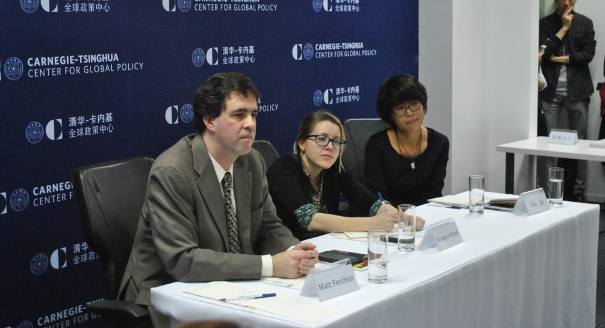Registration
You will receive an email confirming your registration.
China’s economic and diplomatic engagement with Latin America grew dramatically in the 2000s, but global economic trends and recent political transitions in the region have prompted calls for a more balanced and sustainable approach. Sharp declines in the prices of commodities like crude oil and iron ore have exposed Latin American exporters to losses, while recent elections in Venezuela and Argentina may alter patterns of engagement with China. In this shifting environment, both China and Latin American countries will have to adjust to new challenges but also seek new opportunities.
Carnegie–Tsinghua’s Matt Ferchen moderated a discussion among China-Latin America experts about the changing economic and political conditions shaping China-Latin America relations and how future cooperation can promote prosperity for partners on both sides.
Discussion Highlights
The Ongoing Importance of Trade: Panelists agreed that the nature of Chinese-Latin American relationships is unlikely to change dramatically in the coming years, despite political transitions throughout the region and low commodity prices. According to speakers, trade continues to be the foundation of China’s relationships in Latin America, as China continues to import raw materials from the region and export increasingly sophisticated Chinese-made goods such as cellphones and taxi cabs. Although growth in trade has slowed, one panelist predicted that China will continue to have high demand for raw materials, even as the structure of its economy changes.
An Upswing in Investment: Despite slowing global economic growth, one speaker forecasted that China will continue to invest heavily in Latin America, following a threefold increase in 2015, most of which went to Venezuela. Last year, China also announced three funds for regional financing that total $35 billion. Panelists stated that these resources could be transformative for Latin American infrastructure, although it remains unclear precisely how these funds will be distributed, what projects they will support, and whether they represent an added investment or a way of repackaging prior commitments. Meanwhile, the China Exim Bank, which is already a major lender for African countries, is becoming increasingly active in Latin America. Speakers stated that Chinese finance continues to play a major role in the region, surpassing funding from the World Bank and other multilateral lenders.
Heightened Multilateralism and Connectivity: Panelists observed that China’s regional diplomatic engagement is shifting from its traditional bilateral approach to incorporate more multilateral initiatives. Speakers predicted that more will be announced at the next APEC Forum in Peru. Panelists pointed out that China’s economic foreign policy in Latin America mirrors the inclusive tone Beijing has tried to strike in the infrastructure projects it is pursuing through its Belt and Road initiative in Central and Southeast Asia. One speaker remarked that China has shown remarkable dexterity in adapting its approach to different Latin American partners.
Prospects for Diversification: Speakers asserted that although Chinese investment remains focused on infrastructure and extractive sectors, there are signs of greater diversification in the future. In the past few years, top Chinese leaders have announced plans to diversify the country’s economic engagement with Latin American countries through trade, investment, and finance in six key sectors: energy and natural resources, infrastructure, agriculture, manufacturing, scientific innovation, and information technologies. Some Latin American countries have had some success in expanding trade beyond raw materials—Chile, for instance, has done well exporting wine and genetically-modified foods, while Colombia has excelled at selling coffee overseas.
A Rise in Corporate Social Responsibility: Panelists pointed out that Chinese firms are displaying a growing commitment to corporate social responsibility. These companies seem to be putting more stock in the idea that community engagement, due diligence, technological transfers, and best practices help ensure that China maintains a long-term presence in the region and has smooth relations with national governments and local communities. One prominent example is the new standards that China has released for mining operations in the region. While acknowledging that implementation will remain a challenge, panelists concluded that China will continue to be a critical partner in the region and that more must be done to promote strong, enduring relationships.
Margaret Myers
Margaret Myers is the director of the China and Latin America Program at the Inter-American Dialogue.
Guo Jie
Guo Jie is an associate professor in Peking University’s School of International Studies, where her research focuses on China-Latin America relations.
Matt Ferchen
Matt Ferchen is a resident scholar at the Carnegie–Tsinghua Center for Global Policy, where he runs the China and the Developing World Program.
